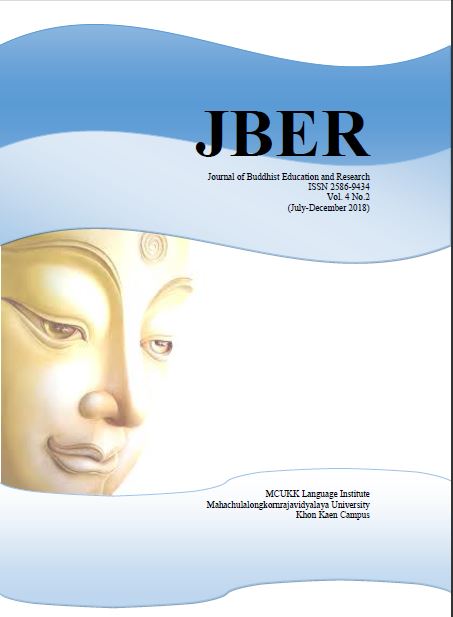BUDDHISM AND EDUCATION IN CAMBODIA – BSD’S BUDDHIST TRAINING TO ENHANCE PEACE AND PROSPERITY
Keywords:
Buddhism, Education, peace and prosperityAbstract
Each and every society has their own way of practicing the beliefs. All faiths they are putting their trust in have a common goal which is to build peace for all human beings. Although they may have and are using various approaches from one to another, they are heading towards the same, final dream, which is to reside in an island of peace, prosperity and harmony. The same applies to Cambodia, one of the Buddhist-dominance state in South East Asia region. Cambodian people are majority Theravada Buddhism. For long time, this religion stays with the Cambodian people’s heart including the low and high or cold and heating situation. Buddhism serves great benefits to Cambodian society until the country has decided to put this special religion as her state religion (One can see more in the Cambodian Constitution).
Like other religions, Buddhism is a religion of peace, nonviolence and a human religion. It has played very important role in maintaining fair development, growth and stable peace. Ideally, the world should have no war or fighting if it could completely follow the teaching of each religion, especially Buddhism.
What are the core education in Buddhism? How these cores contribute to building peace and prosperity in a particular country or state?
The teaching of Buddha is mainly to educate people to live together peacefully. People have got to learn how to live in different environment. People have to be patient. They have to be tolerant and open their mind for something new. Importantly, they be kind and compassionate. They’ve got give hand to each other when in need.
Perhaps, people are different apparently. They may look more beautiful, white, physically strong, and rich than one another. But these things do not count at all. The may speak different language, eating different foods, sleeping different time and wearing different clothes but they share the same pain, suffering and happiness. If suffering and happiness are common things to all people regardless of their skin colors, races, status there must be a common practice towards the elimination of suffering and a common practice towards the creation of lasting happiness.
References
(1) Book :
K Sri Dhammananda. What the Buddhist Believe. Kuala Lumpur: Malaysia, 1973.
Morvillo, Nancy. Science and religion, Understanding the Issues: Printed in Singapore by Ho Printing Singapore Pte Ltd, Set in 10.5/12.5 pt Dante by Graphicraft, Limited, Hong Kong, 2010.
Peter DellSantina. The Tree of Englightenments, chico Dharma study foundation, 1997.
Triratna, Disciples. What is Buddhism?. by Ven. Chin Kung. First edition, 1994.
Ven. Dr. Phangcham. Living Buddhism. Phnom Penh, 1990.
Wehmeier, Sally. Oxford Advanced Learner’s Dictionary, Oxford New York: Oxford, University Press, 2001.
(2) Website :
http://www.tipitaka.net/tipitaka/dhp/verseload.php?verse=160 deride on [20/2/2017].
Khmer:
(1) Book:
ពុទ្ធសាសនបណ្ឌិត្យភ្នំពេញព្រះត្រៃបិដកបាលីនិងសេចក្តីប្រែជាភាសាខ្មែរ(ភ្នំពេញៈរោងពុម្ពវិទ្យាស្ថានពុទ្ធ-សាសនបណ្ឌិត្យ ភ្នំពេញ ព.ស. ២៥០០.
Phnom Penh Buddhist Institute. Pãli Tipitaka and its Translation, Phnom Penh: Phnom Penh Buddhist Institute Press, 2500.
គតិបណ្ឌិត សម្រាប់ពុទ្ធសាសនិក ដោយលោកជំទាវ ខ្លូត ធីតា ប្រធានរាជបណ្ឌិត្យសភានៃព្រះរាជាណាចក្រកម្ពុជាឆ្នាំ ២០០៩.
សកលចិន្តា ដោយព្រះភិក្ខុធម្មបាល ខៀវ ជុំ បោះពុម្ពឡើងវិញឆ្នាំ ២០១៤.
ព្រះពុទ្ធសាសនា និងពាហិរសាសនានៅក្នុងសង្គមខ្មែរក្រោយថ្ងៃរំដោះ៧មករា ១៩៧៩ដោយបណ្ឌិតសភាចារ្យ ខ្លូត ធីតា ប្រធានរាជបណ្ឌិត្យសភាកម្ពុជា បោះពុម្ពឆ្នាំ២០១២.
ការប្រៀបធៀបប្រព័ន្ធរដ្ឋបាលពុទ្ធចក្រ អាណាចក្រកម្ពុជា១៩៧៩-២០១១ ដោយសម្តេចឧត្តមចរិយា បណ្ឌិត ឈឹង ប៊ុនឈា សមាជិកថេរសភាសង្ឃនៃព្រះរាជាណាចក្រកម្ពុជា ឆ្នាំ ២០១១.





